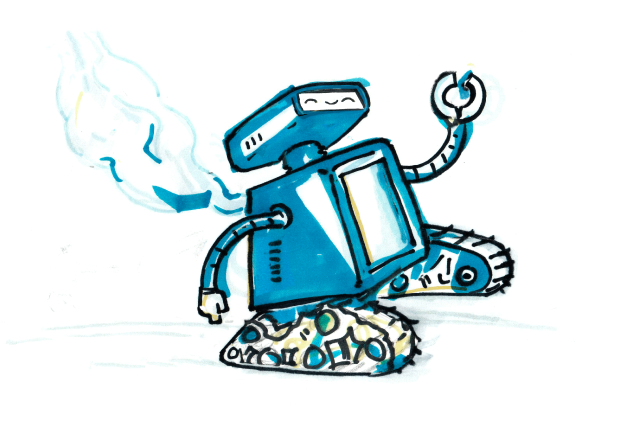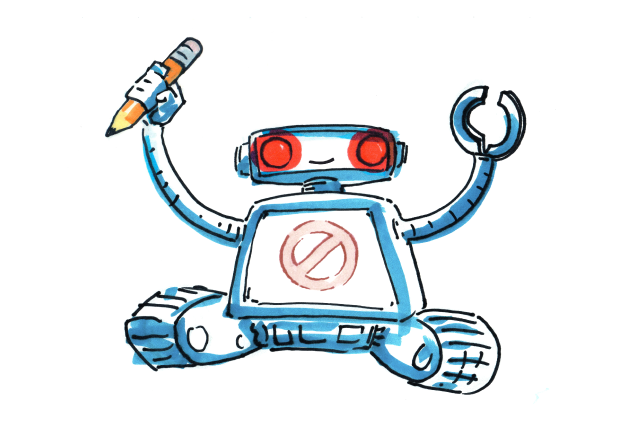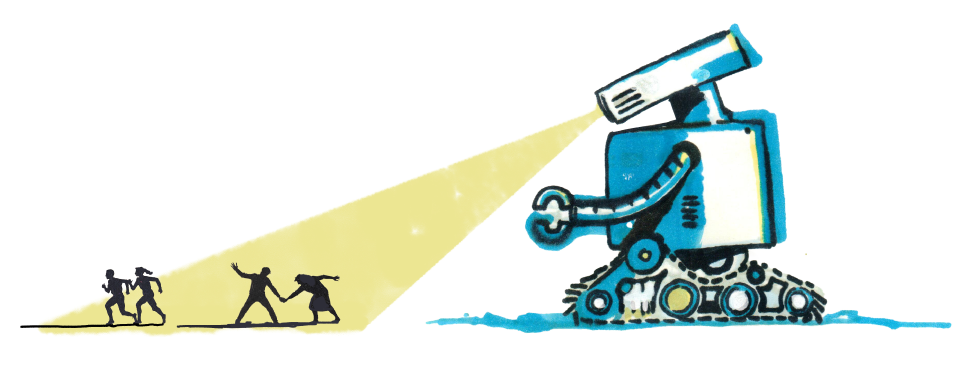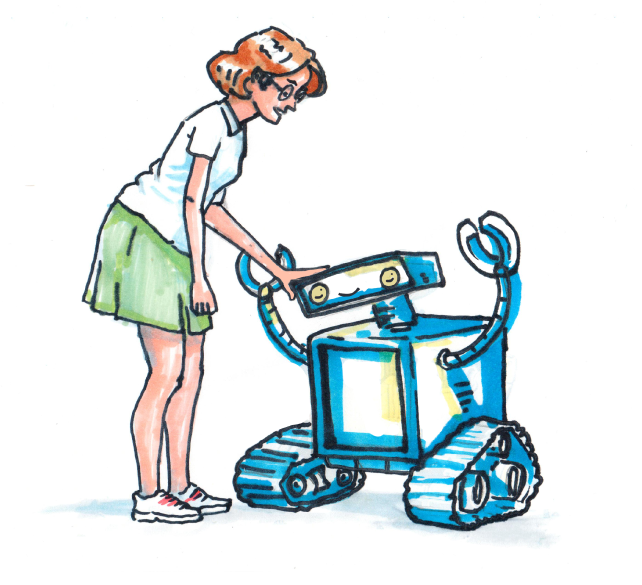Full Steam Ahead
Generative AI for School Communications

I’m writing this article in February, fully aware that by the time April rolls around—or whenever you, the busy school leaders you are, get a chance to read this—the landscape of generative artificial intelligence (GenAI) for school communications will almost certainly have morphed yet again. The past few years have been a masterclass in adapting and pivoting, teaching us that change in today’s world is constant and coming at us faster than ever in unpredictable ways.
I have a unique vantage point in education right now, with dual expertise in both school communications and GenAI. My goal here is to share how I see GenAI reshaping and redefining the foundational aspects of school communications—the ways we build and maintain trust, safeguard our reputations, and strengthen relationships with our school communities.
It’s never been more critical to have trust, accuracy, and human connection at the forefront of our school communications strategies. The GenAI landscape demands a mix of curiosity, caution, and teamwork—with trust as the central pillar.
The Rise of Generative AI
Artificial intelligence (AI) has been quietly working in the background of our digital lives for decades, filtering spam out of our email inboxes and powering the algorithms that customize our Netflix binge-watch lists or LinkedIn feeds. This “traditional” form of AI operates on a predefined set of rules—an algorithm—to understand and interact with the world.
But generative AI (GenAI), the game-changing AI that’s left us all reeling, doesn’t just understand the world—it adds to it by creating brand-new, high-quality content. Large language models (LLMs) have the astounding ability to communicate, create, and even think in ways that convincingly mimic human intelligence.
In November 2022, OpenAI, an AI research lab housed in a repurposed mayonnaise factory, launched a “low-key research preview” of an LLM called ChatGPT, with humble expectations. The night before the launch, company president Greg Brockman predicted a tepid response to the new technology at best—a single tweet thread, maybe 5,000 likes if they were lucky.
But he was wrong. ChatGPT became an overnight sensation, capturing the world’s attention, drawing in a million curious minds within days, and sparking a phenomenon that caught everyone off guard. They weren’t ready. We’re still not ready.

A Catalyst for Change
Picture GenAI as a thundering train barreling through the education landscape with unstoppable force. It’s exhilarating and daunting because we can clearly see that this train has the potential to reshape everything it encounters on the educational terrain. The kicker? Stopping the train isn’t an option.
The Wharton School’s Dr. Ethan Mollick, one of our generation’s most important voices in AI, says that even if AI advances were to stop today, the ripple effect would last years. “Given the inevitability of change,” he explains, “we need to figure out how to mitigate the negative, but also how to channel the change for good as much as possible.” The GenAI train needs skilled conductors to harness its momentum and steer it toward a future where it enhances human relationships rather than diminishing or replacing them.
Trust: The Linchpin of School Communications
Take a minute and think back to your first smartphone. Consider how that device, and the many models you’ve owned since, represented a paradigm shift in how we communicate, and even how we communicate in education. There was a time when school communications was limited to a note home in a backpack and an annual meet-the-teacher night. Today, we use email, text messages, notification apps, social media, and other engagement platforms to support school communications strategies.
Yet when we strip away the complexities, the essence of school communications revolves around two primary objectives: reputation management and relationship cultivation. Ideally, your school or district not only celebrates its victories and navigates crises with grace and transparency, but also actively listens to and meets the diverse needs of its community. School communications isn’t just about sending emails or posting cute Facebook photos; it’s about engaging in meaningful dialogue, where trust and mutual respect are the bedrock of every interaction.
And your school’s ongoing efforts to build trusted online communication channels, implement effective communication systems, and share human-generated content are all about to be more critical than ever before.
A Double-Edged Sword
For years, schools have been integrating traditional AI into the fabric of their communications strategies—from checking grammar to analyzing sentiments in surveys to gleaning insights from social media engagement. Unfortunately, the same AI that boosts the efficiency and impact of school communications also creates a never-ending game of digital whack-a-mole, involving AI-driven phishing attempts, cyberattacks, and waves of mis- and disinformation that flood social media channels daily.
This is the paradox of the digital era: As AI technologies enhance our ability to communicate and connect with our school communities, they simultaneously expose schools to new vulnerabilities, making it even more difficult to protect reputations and strengthen relationships.
Leveling up the risks and rewards of tech-driven school communications is GenAI, playing by an entirely new set of rules. LLMs like ChatGPT operate as if by magic, creating brand-new content—be it text, images, or even music—that is indistinguishable from human-generated work. Yes, you read that right. Even the best AI detectors on the market cannot reliably distinguish AI-generated content from human-generated writing, images, or even phone or video calls. And society doesn’t have any great solutions yet.
Just as tracks guide a train’s path, trust guides the relationship between schools and their communities. Ethical GenAI use will ensure the train keeps moving in the right direction, strengthening rather than undermining trust. Trust is the nexus of school communications, and there are a few key things you need to keep in mind to maintain trust with all of your stakeholders in the GenAI-dominated world.
Generative AI is not just a tool.
You’ve likely heard that GenAI is “just a tool” to add to a school communicator’s toolbox, and in some ways, this is true. GenAI is a tool in the broadest sense—it’s a means to achieve an end. With that said, this tool functions dramatically differently from the traditional tools we’re used to. Consider using a hammer or even a spellchecker; with these tools, your intention directly guides the outcome, and you can reasonably anticipate what will happen when you wield them. They are predictable.
GenAI tools are different. They regularly surprise us with unexpected, even outrageous outcomes. Sometimes it’s impossible to get them to work in the way we need them to. They are wildly creative; they go off-script. And the truth is we don’t know exactly how they work or what’s going on under the hood. That makes them risky in school communications.

Never Trust An LLM.
Accuracy is a critical, nonnegotiable element of school communications. Teachers, parents, and students depend on clear, accurate, timely updates—and the stakes are high. Even a tiny error in communication can ripple through your community, causing confusion and eroding trust.
Here’s the headline: Never trust an LLM, and lay human eyes on every GenAI-generated output before distributing it. LLMs often regurgitate false or biased information retrieved from disreputable online sources and training data. Sometimes they simply creatively embellish facts for no apparent reason, even when accurate data is readily available. These oddities make LLMs a less-than-reliable source of information, even when connected to the internet. Fact-check, cross-reference, and triple-check every output for accuracy or bias every single time. GenAI models are famous for hallucinating facts and delivering misinformation with absolute confidence.
Beware of very real deepfakes.
While the battle against online misinformation and bad actors using technology for nefarious purposes is not new, GenAI is escalating the conflict, making the spread of falsehoods faster and more believable. Hyperrealistic AI-generated deepfakes pose very real threats to school reputations and relationships, and the technology to create them is largely unregulated, easily accessible, and virtually untraceable.
In the earliest weeks of 2024, sexually explicit deepfake images of an AI-generated (but very real-looking) Taylor Swift ignited an uproar, garnering over 45 million views. In the same week, a Hong Kong company lost $25 million following a Zoom meeting featuring deepfaked company executives. And schools are not immune; in 2023, three high schoolers used GenAI to create a deepfake of their principal spewing a racist rant that circulated on TikTok.
Effective school communications in the age of GenAI means ensuring your community knows how to access accurate information on your school-owned online channels when confronted with deepfakes. It’s important that your community knows they can trust the district when these situations arise.
Stay vigilant about privacy and security.
Maintain trust with your school communities by protecting private data. Keep in mind that we don’t know exactly how most of these GenAI systems work, how they are trained, or what makes them tick. Schools must be extra vigilant about unintentional disclosure of sensitive information, including student data, that could potentially violate privacy regulations and laws.
Set clear guidelines about what data should (and should not) be entered into GenAI programs. For example, based on what we know right now (which isn’t a lot), avoid uploading student photos, spreadsheets of survey responses that include participant email addresses, and meeting agendas that may include confidential topics. Rachel Woods, CEO of the AI Exchange, coined the Reddit Rule: If you wouldn’t post it anonymously on Reddit, don’t put it in ChatGPT (or any other GenAI model).

Don’t give up the human touch.
One of the fastest ways to lose trust with your audience is to use GenAI to replace human interactions and human-generated content. Attempting to pass off GenAI content as human-created can have dire consequences for your district’s reputation and trustworthiness. Transparency is key.
It’s deliciously tempting to cast GenAI in the starring role of your school communications story. Certainly, its allure as a prolific writing tool is undeniable—who wouldn’t be enticed by the promises of drafting school newsletters, reports, and announcements in a fraction of the usual time?
Resist the urge. While AI can draft messages that are grammatically perfect and factually accurate, it usually struggles to convey warmth, understanding, genuine concern, and authenticity—all qualities that come naturally to human writers. These human elements are the critical ingredients of effective school communications.
The truth is, while people can’t always tell if written content is human-generated, they trust it more if it is. Research shows that people demonstrate a bias toward content they know was created by humans—a phenomenon known as “human favoritism.” People prefer content known to be human-crafted because they feel people are more trustworthy and empathetic than computers.
Ultimately, human-written content is more likely to resonate emotionally with your school community, which will be even more critical during a crisis or any other time you must address sensitive topics. Transparency and authenticity in our communications are key to maintaining trust.
Without question, the true power of GenAI in school communications lies in casting it in a supporting role, with humans always in the lead.
Using GenAI Strategically
Based on my experience, writing is the least interesting way to use GenAI. Here are six ways you can leverage GenAI to support school communications. Keep in mind that the sweet spot is balancing the efficiency of GenAI with the irreplaceable human element of school communications. (For more information on the tools mentioned here, check out this appendix.)
Simplify your research.
Instead of spending hours searching through pages of Google results, use AI-powered tools like Perplexity AI to automatically find and summarize relevant information on issues important to your school community. These tools link directly to sources and make cross-checking easy. In a similar (but more fun) way, Grok, integrated with the X platform (formerly Twitter), uses GenAI to instantly summarize what people are saying about any topic that impacts your school in real time. (While X may not always be a reliable data source, it can help you gauge public sentiment.)
Catch blind spots.
Use GenAI to assume the role of any stakeholder and identify your communication blind spots. For example, feed a human-created report (after removing confidential information, of course) into ChatGPT and prompt it to review the material from the perspective of your board. This will not only prepare you to address their inquiries, but also help you pinpoint potential information gaps. Similarly, share your written communication messages with ChatGPT, explain who your target audience is, and ask it to evaluate what you might have missed or give you pointers on how to improve it. You may be surprised!
Upgrade your media training.
Ensure your school’s spokesperson is fully prepped for a press conference by casting ChatGPT in the role of local media. Assign the AI any sentiment, topic, or personality to help your spokesperson practice and improve their skill levels. Keep it fun by using the voice conversation feature in GPT-4 to have verbal conversations. Leveraging GenAI strategically in this way not only enhances preparedness but also helps you fine-tune your messaging so it resonates more effectively with each audience.
Enhance your strategic planning.
Use a GenAI like Claude (just to mix it up a bit) to ask you 10 thought-provoking questions to help your team dig deeper into your communications SWOT (strengths, weaknesses, opportunities, and threats) analysis. Have GPT-4 evaluate last year’s strategic comms plan and identify 20 new tactics and strategies for message distribution. You can even work with Perplexity AI to conduct a thorough environmental scan of academic research related to school communications and current trends.
Outsource some of your brainstorming.
Use a friendly GenAI like Pi to ask for ideas on what research may be required ahead of an important engagement campaign. Spend less time coming up with a list of 100 creative hashtag ideas for a school event and more time on the aspects of the campaign where the human element is most critical.
Improve community engagement.
Improve your two-way communication efforts by working with Pi or Gemini to brainstorm different ways to ask important questions or evaluate the effectiveness of survey questions you’ve already written. Partner with an AI tool like Claude to summarize and distill complex information and determine the best way to communicate it with school families. Use AI to evaluate message tones, identify nuance and context in survey responses, and quickly suggest next steps. While protecting private data, work with an AI tool like GPT-4 to analyze survey responses and conduct sentiment analyses on survey data. This will save you hours of time—hours that can be redirected toward actioning the results of the survey and focusing on relationships.
Proactively prepare for crises.
Be better prepared for any crisis by asking ChatGPT to simulate detailed crisis scenarios and evaluate your response from the point of view of a parent. Use Perplexity AI to identify news articles about specific crises and responses, such as handling data breaches in school districts, or collaborate with Pi to ensure your pre-prepared crisis messaging will resonate with your school community. Use ChatGPT to evaluate your school emergency plan’s initial responses, key messages, steps for notifying stakeholders, and strategies for rebuilding trust.

The truth is, it’s an exciting time to be alive. The GenAI train, despite its relentless momentum and dizzying pace, is carrying us to places we’ve never been and showing us views we’ve never imagined. And we’re all going there together.
Full steam ahead.
Subscribe below to stay connected with SchoolCEO!


